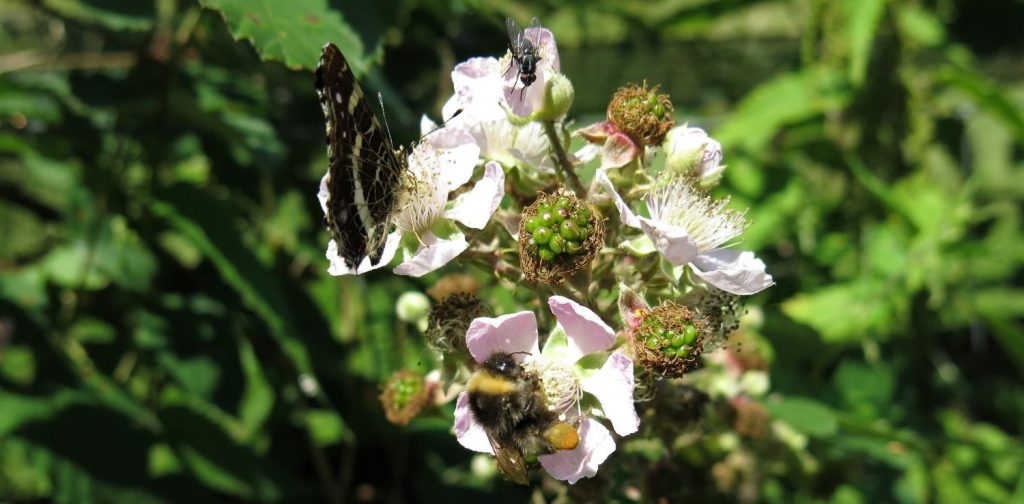Insect diversity, or better, the loss of it is much discussed these days. It’s definitely a good thing that insects finally get into the public discussion. However, there’s quite a lot of simplifications in it. One of them is to reduce the problem by only discussing pesticide use in agriculture. There are many other aspects of the issue.
Still, the debate began to move things. There’s a lot of discussion going on about how to make agriculture more sustainable. The points many agree on: we need habitat for insects and reduce pesticide use. How to get there – that’s another story.
How to increase insect diversity in farmland
There are many initiatives, from different groups, making more or less sense. What is bothering me is the tendency to talk about insect losses and promote beekeeping as a consequence. No. Beekeeping doesn’t help insect diversity, by the single fact that it promotes only a single species. One is contrary to diversity. Even not considering that I don’t think that Western Honey Bees are wildlife.
However, there are also other projects, of course. Many studies and publications talk about the importance of natural habitat in farmland. About the efficacy of flowering strips, hedgerows and the importance of field margins. All these structures help insects providing room for nesting, food and overwintering. Some studies even show that these measures help to increase crop yield, going beyond the conservation of biodiversity.
This is an important point: farmland still has to produce crops. It’s obviously not very realistic to transform it completely into natural reserves. The challenge is to find solutions that do both: maintaining or creating habitat for insects and at the same time give the farmers a living. And, by the way, food for us.
An open question was how much area is needed for creating sufficient habitat. A recent study seems to give an answer: it’s not that much the area, but the “edge density”, the borders between one structure and another, that increase insect diversity. Therefore, already small areas could have a huge effect.
Structural diversity for insects
In addition, there was also a beneficial effect for the farmers: in areas with small structured landscapes, the abundance of pollinators and natural enemies of crop pests increased substantially. Which meant that the pollination improved 1.7 fold and the natural pest control still increased 1.4 fold. And this, in turn, improves crop yield.
This publication is special also because it analysed data from 49 studies in 10 different European countries and a total of 1,515 landscapes. This is important because the agronomic realities are quite different across Europe, and even more so worldwide. There’s no one-fits-all solution for helping insects, it’s the diversity which creates diversity.
This paper provides us with a general framework of how to improve the habitat for insects in farmland. Some starting points, if you like. Small structured landscapes improve insect diversity. How these small structures, with many borders between them look like, may change from country to country, region to region. The challenge now is to transform this knowledge into practical solutions. Without wanting to standardize it too much, accepting that an Italian farmer does things differently to a Dutch one.
A step back for sustainable agriculture
This isn’t trivial at all. Creating habitat for wildlife is work-intensive and sometimes also expensive. If there were a one-fits-all solution, things would be very easy to implement: a simple how-to-instruction would work. On the other hand, calculating compensations for the additional workload would be straightforward. But in this case, we need to accept that a hedgerow or flowering strip may consist of different plants in different regions. Here it is again, the political level of conservation.
However, the larger challenge maybe is that large areas show all the contrary of small structured landscapes. The tendency of the past decades was rather to eliminate structures. In my mind’s eye, I have the landscapes in some areas of Germany which are completely free of structural diversity. Land consolidation in the 1960s was meant to improve yields, make farming easier. It will be difficult to explain why we have to go a step back. But what do you do, when you notice you lost your way on a walk? You go back until you find your track again.
Finding the track
In this case, unfortunately, it’s again a bit more complicated than during a walk. Finding the right track means also rethink subsidies, support farmers in finding the right measures for their region, crop and operation mode and, perhaps most importantly, education. It will be important to do small steps to make sure that there are perceptible results, both for insect diversity (or wildlife in general) and crop yield. Finally, the most motivated farmer may get frustrated if the bureaucracy makes everything difficult. Sustainable agriculture is a marathon, not a Sunday evening stroll. The conditions for engaging in insect-friendly farming must support long-term measures, not just a year with nice flowers along a field.
So what do we learn from this? Sometimes, you have to go back to go forward. To find new tracks you may have to accept some uncertainty and diversity in solutions. And that sustainability also means to respect and support those who are meant to create it.



